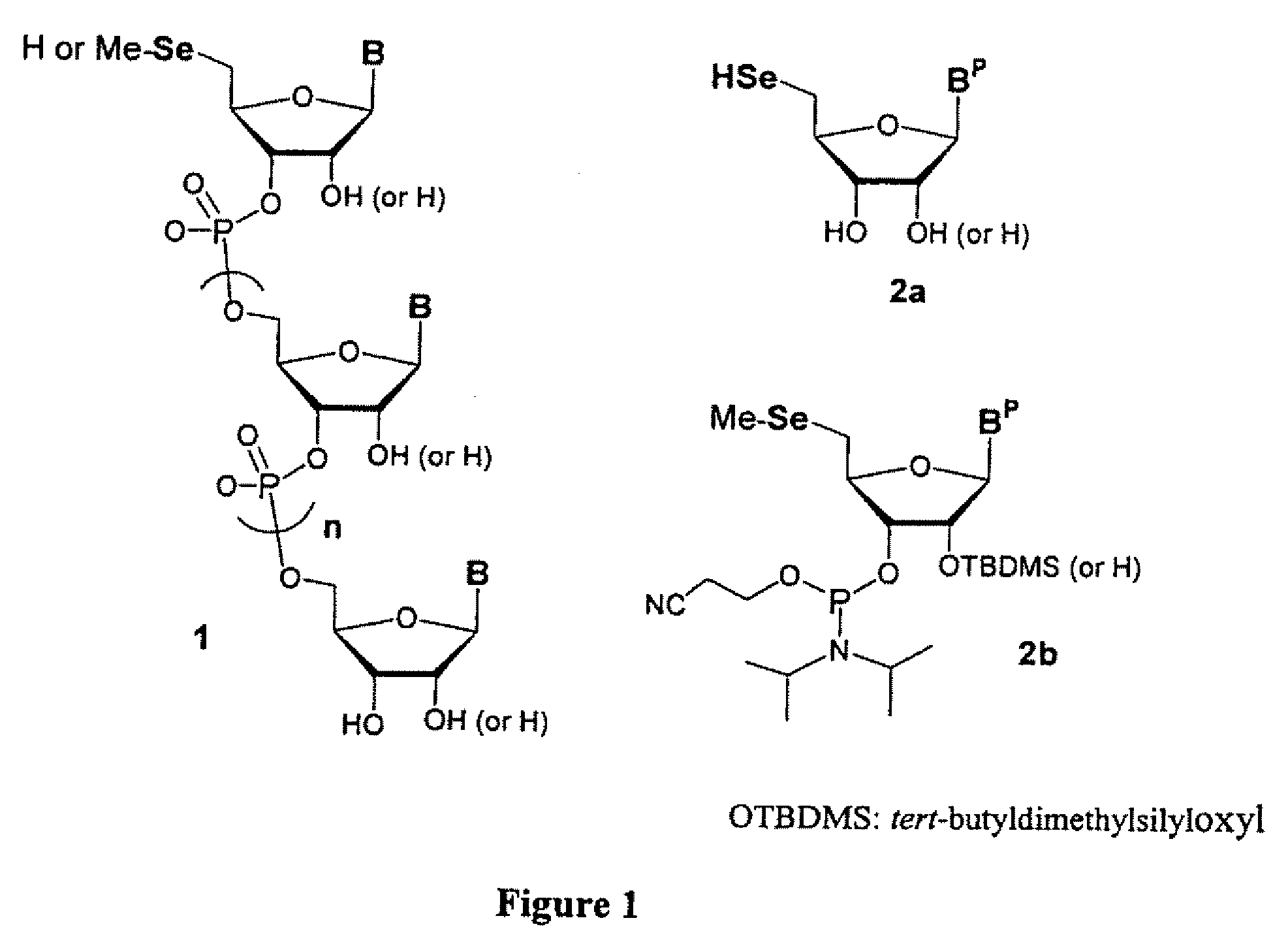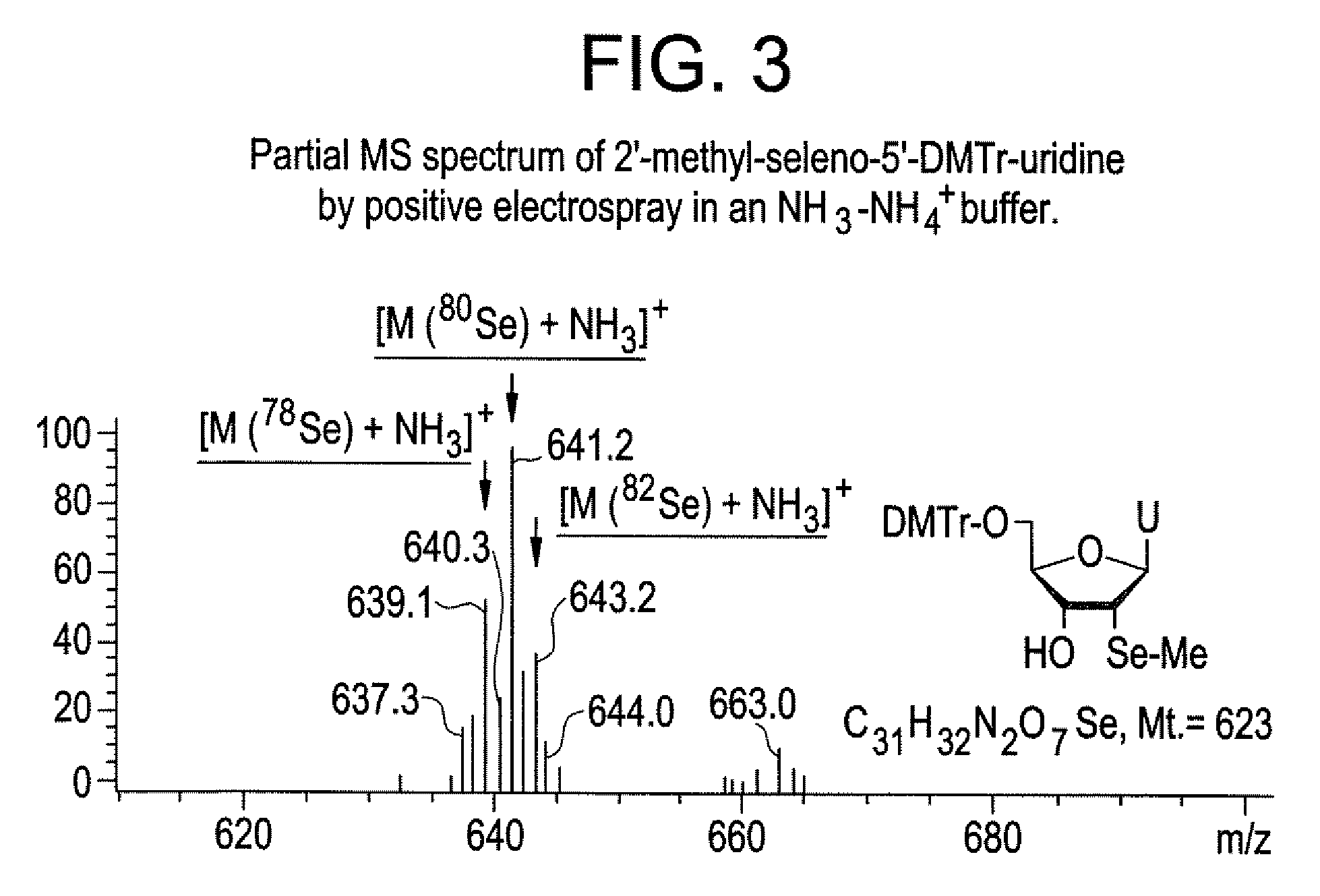Synthesis of selenium-derivatized nucleosides, nucleotides, phosphoramidites, triphosphates and nucleic acids
a technology of seleniumderivatization and nucleosides, which is applied in the direction of application, biocide, group 5/15 element organic compounds, etc., can solve the problems of affecting the structural determination process, affecting the synthesis efficiency of seleniumderivatized nucleosides, and requiring years to prepare derivatives
- Summary
- Abstract
- Description
- Claims
- Application Information
AI Technical Summary
Problems solved by technology
Method used
Image
Examples
example 1
1-[(2R,4S, 5R)-4-tert-butyldimethylsilyloxy-5-bromomethyl-tetrahydro-furan-2-yl]-thymidine (4a)
[0391]3-T (261.1 mg, 0.733 mmol) and Ph3P (577.5 mg, 2.2 mmol, 3 eq.) were placed in a 25-mL round-bottom flask and dried on high vacuum for 1 hr. THF (7.33 mL, final conc. 0.1 M), TEA (614 μL, 6 eq.), and CBr4 (729.72 mg, 2.2 mmol, 3 eq.) were then added sequentially. The reaction mixture was stirred at RT under dry argon. The reaction was completed after 15 min as indicated by silica gel TLC (5% MeOH / CH2Cl2, Rf 0.46). MeOH (0.5 mL) was then added to consume any excess reagent, and the reaction mixture was stirred for another 15 min. All the solvents were removed by rotary evaporation under reduced pressure at 30° C. The crude product was then dissolved in EtOAc, the salt was removed by filtration, and the solvent was evaporated. The residue was directly applied to a silica gel column (25 g of silica gel), and the column was eluded with EtOAc / Hexane (3:7). This solution precipitated the ...
example 2
N6-Benzoyl-1-[(2R,4S, 5R)-4-tert-butyldimethylsilyloxy-5-methanesulfonyl-methyl-tetrahydrofuran-2-yl]-adenine (4c-A)
[0396]3-A (54.0 mg, 0.115 mmol) was placed in 10-mL flask and dried on high vacuum for 2 hours. THF (2.3 mL) and TEA (47 μL, 0.345 mmol, 3 eq) were then added, and the flask was placed on an ice-water bath and kept under dry argon. Methanesulfonyl chloride (13 μL, 0.17 mmol, 1.5 eq) was added and the reaction was completed in 15 min. (silica gel TLC in 5% MeOH / CH2Cl2, 4c-A Rf=0.35, 3-A Rf=0.30). MeOH (1 mL) was added to consume the excess reagent and the reaction was stirred for another 15 minutes. The solvents were removed by rotary evaporation at 40° C.; the residue was dissolved in EtOAc (15 mL), and the solution was filtered. The filtrate was then evaporated, and the residue was purified on silica gel G60 column (gradient, from 0 to 5% MeOH / CH2Cl2). The collected fractions were evaporated under reduced pressure and dried on high vacuum overnight. A colorless foamy ...
example 3
N2-isoButyryl-1-[(2R,4S, 5R)-4-tert-butyldimethylsilyloxy-5-methane-sulfonyl-methyl-tetrahydrofuran-2-yl]-guanine (4c-G)
[0399]The same procedure for 4c-A was used to prepare 4c-G. The mesylation reaction was complete in 1.5 hours. After the column chromatography over silica gel, 4c-G was obtained in 94% yield.
[0400]1H-NMR(CDCl3) δ: 0.15 [s, 6H, (CH3)2Si], 0.93 (s, 9H, t-Bu), 1.25 [s, 6H, (CH3)2C], 2.35-2.64 (m, 2H, 3′-H), 2.76 [sept, J=6.9 Hz, 1H, CH(CH3)2], 3.07 (s, 3H, CH3—SO3), 4.12-4.25 (m, 1H, 5′-H), 4.31-4.52 (m, 1H, 4′-H), 4.58-4.72 (m, 2H, 5″-H), 6.21 (dd, J=6.0, 6.8 Hz, 1H, 2′-H), 7.73 (s, 1H, 8-H), 8.87-8.95 (br, 1H, NH, exchangeable by D2O).
[0401]13C-NMR (CDCl3) δ: 17.84 (CH3—Si), 18.82 [(CH(CH3)2)], 25.60 [(CH3)3C], 27.59 (CH3SO3), 36.49 [(CH(CH3)2], 41.46 (C3′), 66.35 (C5″), 71.36 (C5′), 86.81 (C4′), 89.27 (C2′), 122.48 (C5), 138.47 (C8), 146.89 (C4) 147.36 (C2), 155.86 (C6).
[0402]UV (in acetonitrile): 266.8 nm.
PUM
 Login to View More
Login to View More Abstract
Description
Claims
Application Information
 Login to View More
Login to View More - R&D
- Intellectual Property
- Life Sciences
- Materials
- Tech Scout
- Unparalleled Data Quality
- Higher Quality Content
- 60% Fewer Hallucinations
Browse by: Latest US Patents, China's latest patents, Technical Efficacy Thesaurus, Application Domain, Technology Topic, Popular Technical Reports.
© 2025 PatSnap. All rights reserved.Legal|Privacy policy|Modern Slavery Act Transparency Statement|Sitemap|About US| Contact US: help@patsnap.com



